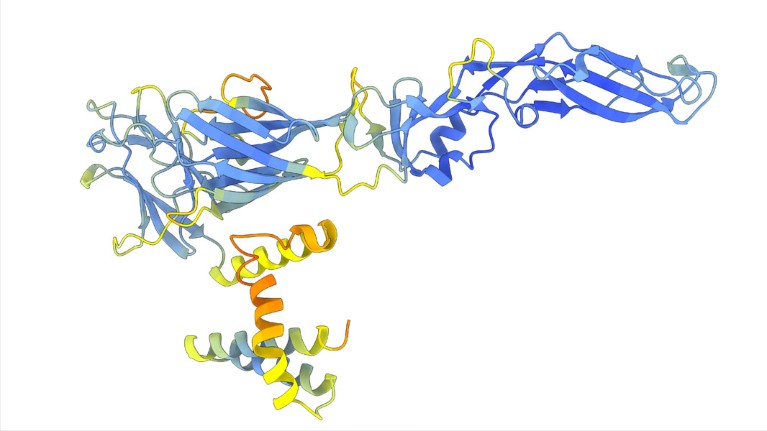Hello Nature readers, would you like to get this Briefing in your inbox free every day? Sign up here.

Credit: Spyros Lytras and Joe Grove
Protein structures predicted by AI models have revealed some twists in the evolution of flaviviruses — a group that includes hepatitis C, dengue and Zika viruses. Researchers used DeepMind’s AlphaFold2 and Meta’s ESMFold to generate more than 33,000 predicted structures for proteins from 458 flavivirus species. They already uncovered some surprises. For example, the hepatitis C virus infects cells using an entry system similar to one seen in the pestiviruses — a group that includes animal pathogens like swine fever. Another big surprise was the discovery that some flaviviruses have an enzyme that seems to have been stolen from bacteria.
Nature | 5 min read
Reference: Nature paper
Rising temperatures and heavy rainfall are turning Europe into a breeding ground for mosquito-borne diseases, researchers warn. New figures show there have been 715 locally acquired cases of West Nile virus across 15 European countries this year. Climate change is creating cosy conditions for Culex pipiens and Aedes albopictus mosquitoes in places they couldn’t previously thrive, extending their range and the transmission period of the diseases they carry. “We are faced with a problem where new places could become hotspots of transmission that were not prepared for this before,” says genetic epidemiologist Houriiyah Tegally.
Nature | 5 min read
Reference: European Centre for Disease Prevention and Control report
Researchers took 26 MRI scans of one woman’s brain during her first pregnancy to chart how her brain changed in unprecedented detail. The 38-year-old woman, who conceived using IVF, gave scans and blood samples starting before conception and extending for two years after the birth of her child. The data show a widespread decrease in grey matter, and a temporary increase of white matter toward the end of the second trimester, both linked to hormonal changes. “The maternal brain undergoes this choreographed change across gestation and we’re finally able to observe the process in real time,” said neuroscientist and study co-author Emily Jacobs.
The Guardian | 4 min read
Read more: How pregnancy transforms the brain (Nature | 9 min read, Nature paywall)
Reference: Nature Neuroscience paper
Work to develop a supercomputer that could out-pace the world’s current fastest by 1,000 times is officially underway. Expected to cost the Japanese government around US$775 million, the Fugaku Next machine should be online by 2030. The world’s fastest current supercomputer functions in the realm of one quintillion (1018) calculations per second, or exaFLOPS. Fugaku Next is expected to operate in the realm of zetaFLOPS, 1,000 times that speed.
Popular Mechanics | 3 min read
Features & opinion
There is a steadily growing number of industry and academic efforts to build AI models that can derive fundamental biological principles based on protein, RNA, DNA or even cell imaging data, and then use those principles to guide diverse analytical or design tasks. Many of these are described as ‘foundation models’ — a term that broadly describes systems that perform well across a range of different problems through a process of ‘pretraining’ on enormous, unlabeled datasets. This is in contrast to most machine- and deep-learning algorithms in the biology world, which tend to be focused on very specific tasks.
Nature Biotechnology | 10 min read
The universal nature of science, with its supposedly neutral language and methods, provides common ground for communication between people – and so can help build peaceful relations between nations. At least, that’s an argument that’s often made, and science historians Roberto Lalli and Jaume Navarro unpick it in an essay for Nature. They explore the many ways that physicists, both individually and collectively, navigated geopolitical tensions throughout the twentieth century, and what scientists more broadly can learn from that when considering responses to, for example, the ongoing war in Ukraine.
Nature | 10 min read
In his new book, The Burning Earth: A History, Sunil Amrith chronicles the fights of the poor and powerless against those seeking to profit from the planet’s natural resources throughout history. A testament to perseverance, Amrith narrates the rebellions of environmentalists over the past 600 years “with flair, in his epic exploration of human innovation and destruction”, writes Josie Glausiusz, as he brings us to the movements still fighting for Earth’s future today.
Nature | 6 min read
Today I’m trying to decipher Hounds and Jackals, one of the oldest known board games. It was thought to have originated in ancient Egypt, but archaeologists have just found a board in Azerbaijan — suggesting that it has even older roots in Asia.
Let us know what you’re playing at — plus any other feedback on this newsletter — at briefing@nature.com.
Thanks for reading,
Jacob Smith, associate editor, Nature Briefing
With contributions by Flora Graham and Sarah Tomlin
Want more? Sign up to our other free Nature Briefing newsletters:
• Nature Briefing: Careers — insights, advice and award-winning journalism to help you optimize your working life
• Nature Briefing: Microbiology — the most abundant living entities on our planet — microorganisms — and the role they play in health, the environment and food systems.
• Nature Briefing: Anthropocene — climate change, biodiversity, sustainability and geoengineering
• Nature Briefing: AI & Robotics — 100% written by humans, of course
• Nature Briefing: Cancer — a weekly newsletter written with cancer researchers in mind
• Nature Briefing: Translational Research — covers biotechnology, drug discovery and pharma
